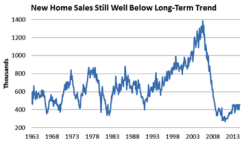In recent months we at BlackRock have argued that neither the slowdown in global growth nor the strength of the dollar would place the U.S. economic recovery at risk. Therefore, the U.S. Federal Reserve should remain on pace to begin normalizing the fed funds rate sometime in the first half of 2015 — a 75 percent likelihood in our view. Furthermore, we have made the case that the U.S. economic recovery is progressing more strongly than many have been willing to admit, a fact underscored by the Fed’s recent upward revision to expected 2014 real gross domestic product growth and its downward revision to the unemployment rate at year’s end. Still, one large segment of the economy that is not participating in the recovery as fully as it might is the housing and construction industry.
Whereas home prices in the U.S. have significantly recovered from financial-crisis lows, appreciating more than 20 percent since the first quarter of 2012, the rate of those gains has slowed of late. Indeed, the S&P/Case-Shiller 20-City Composite Home Price index gained 4.5 percent year-over-year for October 2014 (data released today) — only a modest deceleration from the prior period but quite a bit slower than the double-digit gains seen in 2013. By this measure, home prices are back to levels last seen in late 2004 but are still well short of their precrisis peak. That degree of deceleration in home price appreciation is not surprising to see as the share of distressed-property sales declines and markets continue to normalize. As a result, we would expect that national home price appreciation rates should stabilize further in 2015.
From the standpoint of the supply and demand for homes today, there are supportive supply-side elements that contend with some demand-side challenges, both of which we believe should continue to abate in 2015. Existing home inventory and shadow inventory (foreclosed real estate that has not yet been sold or homes that owners are waiting to sell until prices rebound) have declined meaningfully from late-2010 peaks, as has the share of distressed-property sales, particularly in areas hardest hit during the financial crisis. Also, new home construction has remained depressed, with levels of both building permits and housing starts still well below 2005 levels, despite some improvement in the multifamily segment in recent years. Still, there is meaningful geographic divergence in the aggregate data. The Northeast has lagged in clearing backlogs of foreclosures, in part because of the high concentration of judicial foreclosure states in the region.

Source: Bloomberg
On the demand side, the often-discussed deals by institutional investor purchasers and those using all cash have started to decline, as the housing market continues to normalize. Still, weak levels of household formation and weak income growth in the wake of the recession have led to anemic new home sales, which still reside at levels that are well below their long-term trend (see chart). Historically, household formation tends to track employment growth closely. But that has not been the case in this cycle, which has seen significant improvements to the labor market over the past couple years while household formation has remained subdued.
Although 12-month-average household formation is a volatile data series, its movements have exhibited a decent correlation to trailing 12-month changes in payrolls, at least until 2010, when the relationship appeared to break down, according to Evercore ISI research. Why homeownership rates among young adults (18 to 34 years old) in particular have declined to 37 percent, or roughly 6 percent below peak levels, according to the U.S. Census Bureau, is a topic that invites much speculation.
Our view is that the recent recession hit this demographic cohort particularly hard, in terms of disproportionately high levels of unemployment and weak income gains for those lucky enough to be employed. Furthermore, as income gains have not kept pace with home price rises, home affordability relative to income has been particularly challenging for this group. Despite some recent improvements, credit has been tighter for those with lower incomes and those unable to build substantial down payments, a group that tends to comprise young first-time home buyers. Some have suggested that this generation may simply be less interested in homeownership, having come of age at a time of a housing crisis, but the survey data we have examined, including from Gallup and Bank of America, do not support such a conclusion. It is more likely that we are merely witnessing a delay in household formation and home purchasing, not outright avoidance.
An important factor that we think is a major headwind to first-time home purchasing but which would also respond to fiscal measures is the high level of student loan indebtedness among young people today.
Ultimately, whereas we think continued accommodative policy on the part of the Fed as it slowly normalizes front-end rates in 2015 will help support housing, it is fiscal support for those with high student loan burdens that would be a more direct aid to new home sales potential. Regardless of whether such support is forthcoming, though, the continued strengthening of labor markets and the positive disinflation we have described in the past should go some distance toward allowing the housing market to normalize further. As it does, we may see construction activity pick up in 2015 and employment in the sector lead to further labor market gains. This is clearly an area of the economy that would benefit from fiscal action, so if policymakers could bridge their divides and support a stronger housing sector, we could see the one missing link in the recovery turn out to be the key to further improvement.
Rick Rieder is chief investment officer of fundamental fixed income and co-head of Americas fixed income, and Ron Sion is the head of the agency mortgage-backed securities team within Americas fixed income, both at BlackRock .
Get more on macro.






